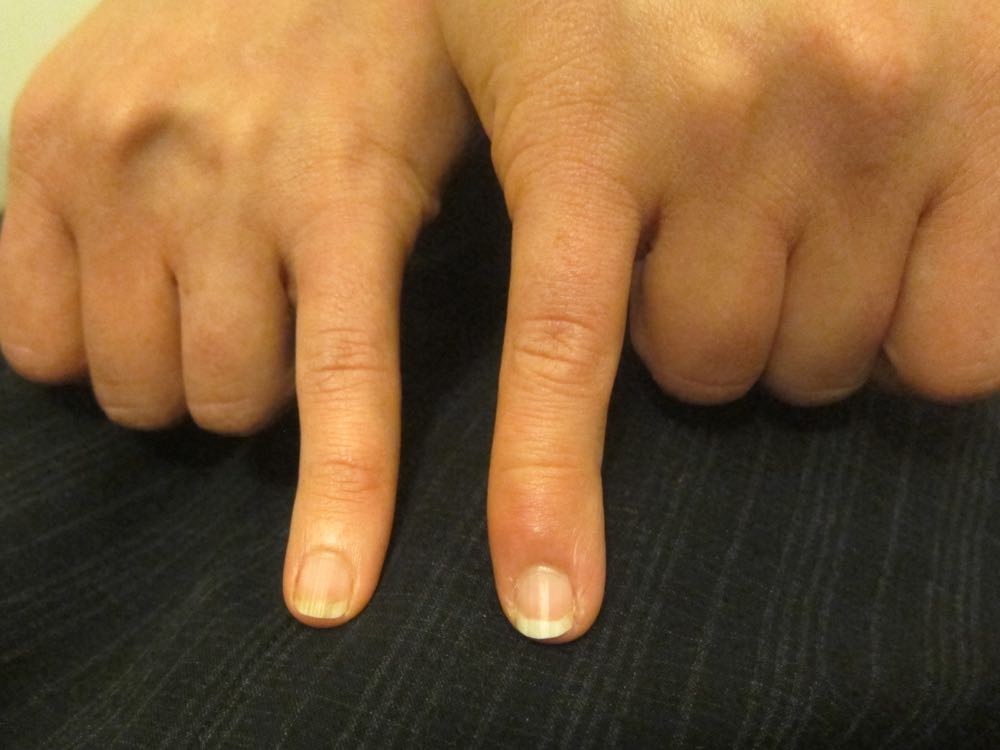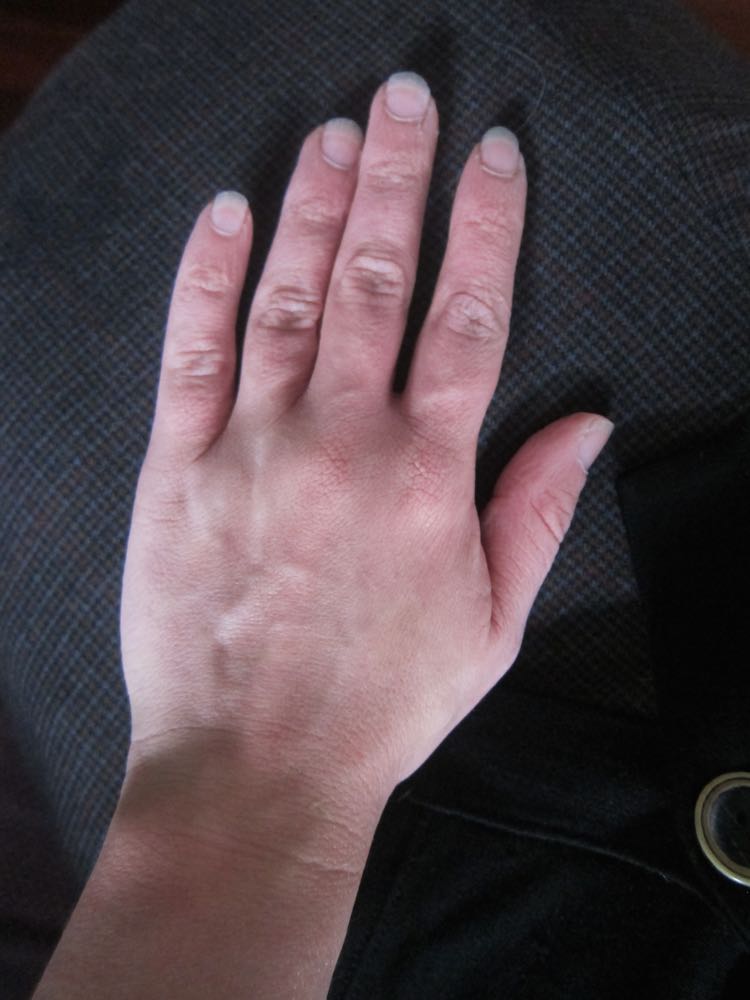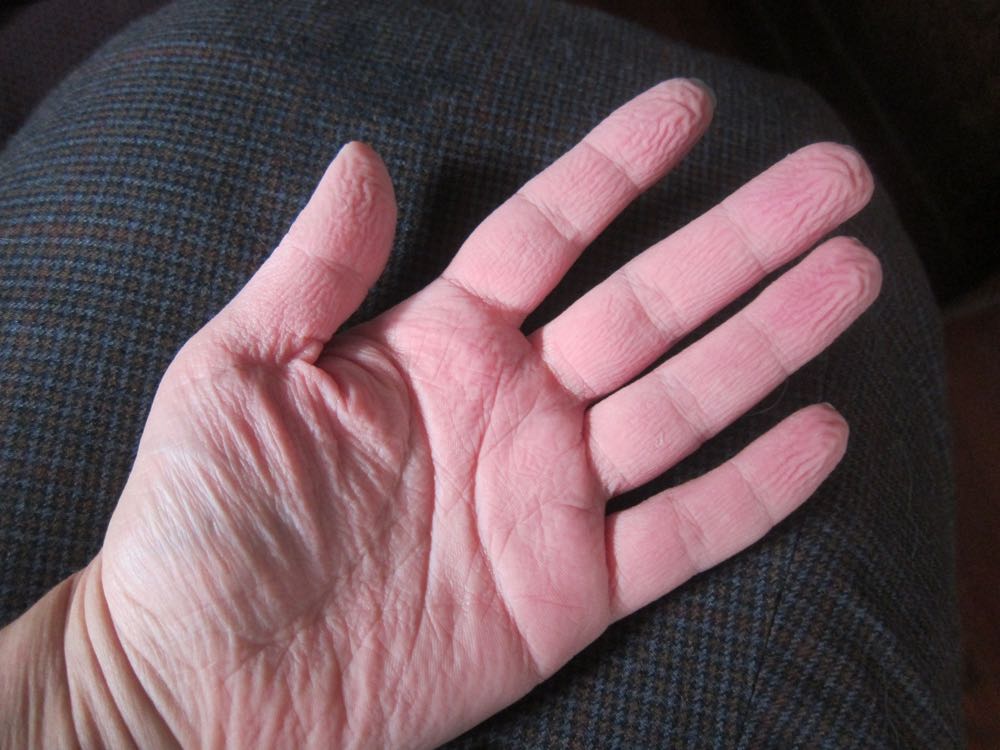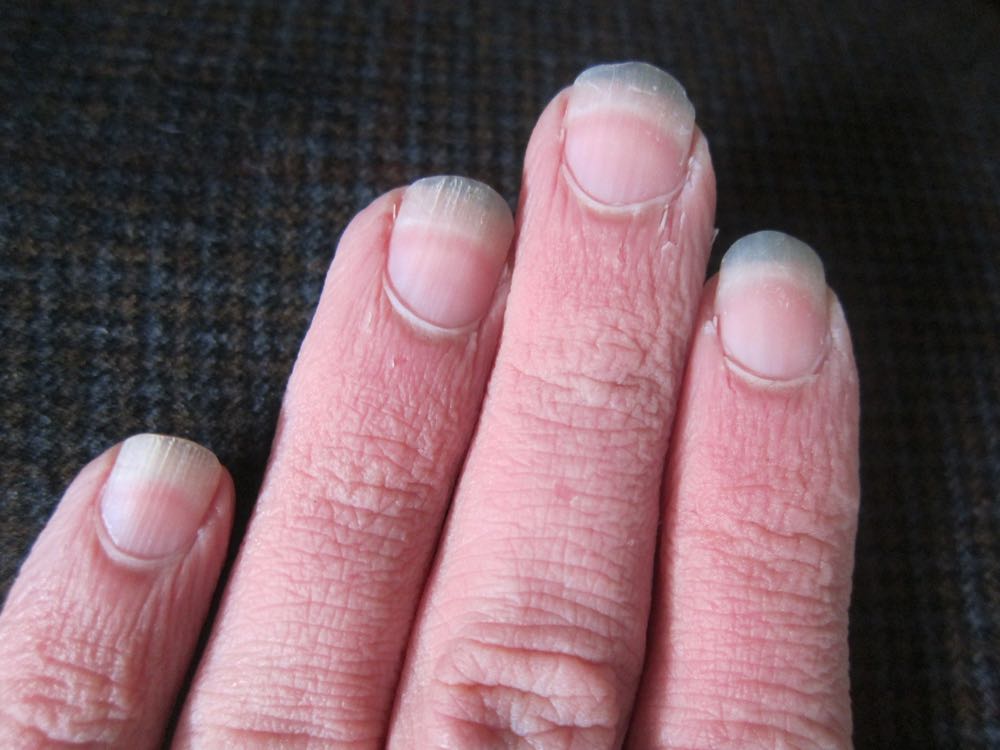At the start of the Fortnight in 1916 project, one of my rules was that I wasn’t allowed to continue the experiment if it put my health in any danger. Happily, except for some minor blood blistering from a bad corset, I came through the experiment in perfect health – probably even better than if I’d spent it living 2016 style.
My main worry about the fortnight was the cold. Would using less heating in the middle of winter, and wearing nothing but wool stockings on my lower legs, increase my chance of chillblains or a bad chest cold?
I hadn’t managed to make a wool union suit, and compared to the layers of socks and merino thermals I usually wear in winter (the July standard is two layers of socks, heavy jeans, and at least three layers of wool on my torso), my 1916 wardrobe seemed quite insufficient. Every day I would be wearing a single pair of thin-ish merino stockings, cotton combinations, a one-layer cotton corset, corset cover, two cotton petticoats, a thin-ish wool skirt, cotton blouse, and a wool cardigan. It didn’t seem like much!
It worked.
I was lucky in that we have been having a very mild winter, but even in the properly cold days we had, I was toasty warm and comfortable. I hardly even wore the cardigans. Even in cotton, all the layers, with space between them, were fantastic insulation. The corset kept my core nice and toasty, and with my core warm, my extremities were a lot warmer too. My feet were never cold in their stockings (learn how to make your own here), and I didn’t struggle with wearing stiff heeled shoes all day (which I had worried about).
Maintaining a comfortable body temperature was also helped by how much I moved around: the corset made sitting on anything but a straight chair less-than-fabulous, and lounging on the couch was definitely out of the question. I didn’t get nearly as much writing as I had hoped completed in the fortnight, because I never wanted to sit down.
I was so astonished and pleased by how warm I was in every circumstance, that I’m now trying to figure out how to incorporate the effect into my standard winter wardrobe. It’s a bit tricky, as I need to be able to sit comfortably for much of the day in my regular life, and the corset does not facilitate that
I was so warm I only got very mild chillblains doing laundry 1916 style, when my hands were damp for hours on end outside in the wind, which would usually give me a very bad attack. The lack of chillblains could partly be because I’d recently been in Hawaii, and I seem to have a slight buffer before getting them again after being summer warm, but I’d been back in NZ for two weeks before the Fortnight experiment started, so that buffer should have worn off.
Here is an example of what my chillblains looked like at their very worst, at the end of the Fortnight:
While chillblains weren’t too bad, the Fortnight was VERY hard on my hands in other ways. Lots of dishes, lots of laundry, and no rubber gloves. It’s easy to see why methods for achieving soft, white (sorry, period racial overtones definitely come into play here), un-callused hands appear so prominently in advice columns and advertisements at the time.
Here are my hands after my second round of doing laundry, circa 1916:
It took me weeks to get them back into shape, and get back to nice strong nails, with no hangnails. And I’m not even remotely precious about my hands in ordinary life. It would be hard to keep your hands in good condition doing 1910s housework: you really might be able to tell social status by hands.
So, I was nice and warm, my hands were trashed, what else happened?
Well, despite cooking everything in butter, the lack of vegetables in my diet, the high amounts of carbohydrates, and a sweet dessert most days, I actually lost two kilos over the fortnight.
I weighted myself numerous times a day in the week running up to the fortnight, and the days after, and my post-Fortnight high and low weights were definitely 2 kilos (almost 5 lbs) lighter than my pre-Fortnight high and low weights.
My theory is it was the extra exercise from walking everywhere, doing so much physical labour in housework (let me tell you, doing laundry was a workout), some reduction in appetite from wearing a corset, and simply the effort of wearing all the clothes I was wearing.
In addition to loosing two kilos, I lost two inches of waist circumference. I was really impressed, as the corset I wore every day gave me very little waist compression, but it was enough to do something.
Despite the weight loss and waist loss, I have no intention whatsoever of taking up the 1916 weightloss diet. Living in the corset made it too hard to do the computer work I need to do on a daily basis, and you have to do a ton of exercise to retain muscle tone in your back and stomach if you wear a corset full-time, as it does the work those muscles would usually do. I couldn’t wear the weight of clothing I was wearing without a corset.
Finally, in case you are wondering how long it took for the corset-pinch blood blisters I got on day three of the Fortnight to go away, the answer is just over two weeks. Here is what they looked like the day after the Fortnight ended:
They were more obvious in real life than the photo shows.
So, that’s what living in 1916 did to my body. It would be really interesting to see what would happen over a longer experiment. Would I continue to loose weight at the same rate, or would my body adapt? I’d definitely take much more care of my hands, were I to attempt it again.







sewcharacteristicallyyou.comThanks for sharing. It is interesting to note the differences in lifestyle between the 20-teens and the 19-teens. From all that you have said, it is also important to realize the physical effects that such a difference can have. All of the physical aspects make perfect sense, but I would not necessarily have thought of them. It does make me think of the differences in physical lifestyle between my own generation and those that I am historically interested in.
Sarah
http://www.sewcharacteristicallyyou.com/blog
Thank you for sharing! I’m so fascinated by this project, and would really like to try something similar sometime. Interesting about the hands – for us today it seems a bit weird that you could tell someone’s class just from looking at their hands, but when you think about all the abuse hands would take before modern labour saving appliances, it makes total sense.
Ouch, ouch, ouch! Your poor hands! I’m having sympathy pain. Mine were very bad after our last move. Too much packing paper, boxes, cleaning products/water, and drying my hands with paper towels – meant super dry skin, and eventually, a lot of cuts, splits, and bleeding. I didn’t think they’d ever look the same again. They probably don’t, but at least they went back to looking like ordinary hands!
I’m sure the corset blisters were worse, but the photo doesn’t quite do them justice.
I wonder if you could make something out of wool knit to help with the core-warming, and still be comfortable? Something similar to the Japanese under-garment, which is supposed to keep one’s kidneys (and probably other organs) warm. I can’t remember the name for it. It could be an extra layer of warmth, without running into that restricted feeling one tends to get if really piling on the layers in the shoulder/arm area.
Your entire Fortnight in 1916 project is so interesting.
The effects of 1916 on your hands makes me wonder about all the poor souls in the past who had severe skin problems. I have bad dermatitis and that picture of your hands looking bad after all the washing is what my hands look like on an amazingly good day in winter. On a bad day they don’t bend because of the number of cracks on them, and the itchiness from the dryness is torture. I wonder how I’d have managed all that in 1916? (ignoring the fact that an infection from my bad skin probably would have killed me off before adulthood) Maybe I’d have tried every snake oil treatment out there for helping bad skin, or Macgyvered up some sort of barrier to protect my hands. Or maybe I’d have teamed up with a friend or family member and taken on a share of their housework in exchange for them doing my washing. Or maybe life would just have been a misery.
I’ve been told that my grandmother (in the mid-20th century) used to slather cold-cream on her hands before bed and cover them with cotton gloves. A bit of a passion-killer, perhaps, but certainly helps with the drying flaking skin thing.
Glycerine and rosewater. The standard hand care product, as used by my mother, aunts, and grandmothers. Available from the chemist – or once was. It helps, but not a lot. Nothing does, except rubber gloves, bless them, and washing machines and dishwashers, ditto. Shows a practical reason for the fashion, indeed, the necessity, of wearing gloves when ‘going out and looking respectable’.
The core temperature question is interesting. There must be a way to solve this. Onionization helps, but I’m sure you’re already doing this. You know – tuck A into B, C into D, and possibly E into F. A, C, and E need to be nice and long so that there is a big area of overlap. This is why old ladies’ singlets are long enough to cover their bottoms!
Everything affects everything else, doesn’t it! Such an interesting experiment!
I have both glycerine and rosewater in the house on a standard basis, they shouldn’t be too hard to mix. There is a terrible/funny story about buying the glycerine actually. I needed it for candlemaking when I hadn’t been in NZ that long, so I tried to buy it at the supermarket. The young guy at the customer service desk gave me a very startled look when I asked for it, and said he’d have to ask his manager. He scuttled off, and came back looking very shamefaced, with his intensely amused manager, who was struggling not too loose it – the poor young guy didn’t realise there was another kind of glycerine, and had worriedly reported someone who was trying to buy bombmaking materials (nitroglycerine) at New World!
I did use a hand cream from a recipe that wasn’t too far off 19th c originals. But nothing can compete with rubber gloves!
Oh my goodness! That is so funny, and also awful. 🙂
What a great story! I guess it was a learning experience for the young guy.
Oh, how funny!!
The whole time while reading this I kept wonder what the heck chillblains were. I’ve never heard of it. Of course I looked it up and get the general idea now. I guess I’m toouch of a California girl. Are they something g you get every winter?
Sigh, I’m terrible at typing on my phone!
Having had a quick look at what you get in a chillblains image search, mine don’t look nearly as gross as most of the examples!
Yes, I’ve had chillblains every winter I’ve spent in NZ. I have extremely low blood pressure, and extremely poor circulation, and they add to it – I don’t know many other people in NZ who get them as badly as I do. I’d heard of them in books, but didn’t really know what they were until I moved here. Don’t feel bad that you don’t know what they are – I took my first case of them to a doctor in CA and she had no idea what they were either!
Haramaki (Japanese belly warmers) are usually just a band of fabric that is wrapped or pulled on. A thin wool camisole or vest might work as well? I’m a huge fan of contemporary wool – wearing all allbirds wool shoes right now – as it’s gotten much easier to find soft, next-to-the-skin comfortable wool. Outdoor adventure enthusiasts base layers may be helpful to look at too; insulation, breathability, and comfort are important for those activities.
I am always chilly in the winter (low BP, low body fat), so I made myself a pair of jumps to have the quilted layer on my torso. It’s amazing how keeping the torso warm effects the extremities!
Re: the hands, I grew up reading Beautiful Girlhood (Mabel Hale, 1922), a book aimed at teaching character to young girls, and there’s a lot in there admonishing girls that they should not shirk housework just to have pretty hands, because the most beautiful hands are the ones that help their mothers! Or Jacob Have I Loved, where the unloved sister spends her hard-earned money on hand-cream, and is enraged to find her pretty sister using the stuff. I never understood the big deal about hand care until now!
[WORDPRESS HASHCASH] The poster sent us ‘0 which is not a hashcash value.
Fascinating! I loved this post just as much as the previous one!
Do you think all that moving around doing chores might have boosted your circulation a bit?
It seems like quite a healthy lifestyle in terms of the activity and exercise, although I think if it was me I would miss my leafy greens. Definitely not good for the hands though. You’d certainly be able to tell someone’s status from their hands.
Surely you can find a way to keep your core warm without a real corset!
Was it the hip/skirt part of the corset that made sitting so uncomfortable?
I wear either knee socks or stockings plus bike shorts or tap pants and skirts all winter and people are constantly asking me if I’m not freezing. Frankly it’s much much warmer than pants! Seconding the japanese belly warmer tip – I need to get another one. You could just make a circle of a knit fabric for the same kidney warming effect.
You were so brave to get through the fortnight! And lost weight! – what could be better?? Keep up the active lifestyle!